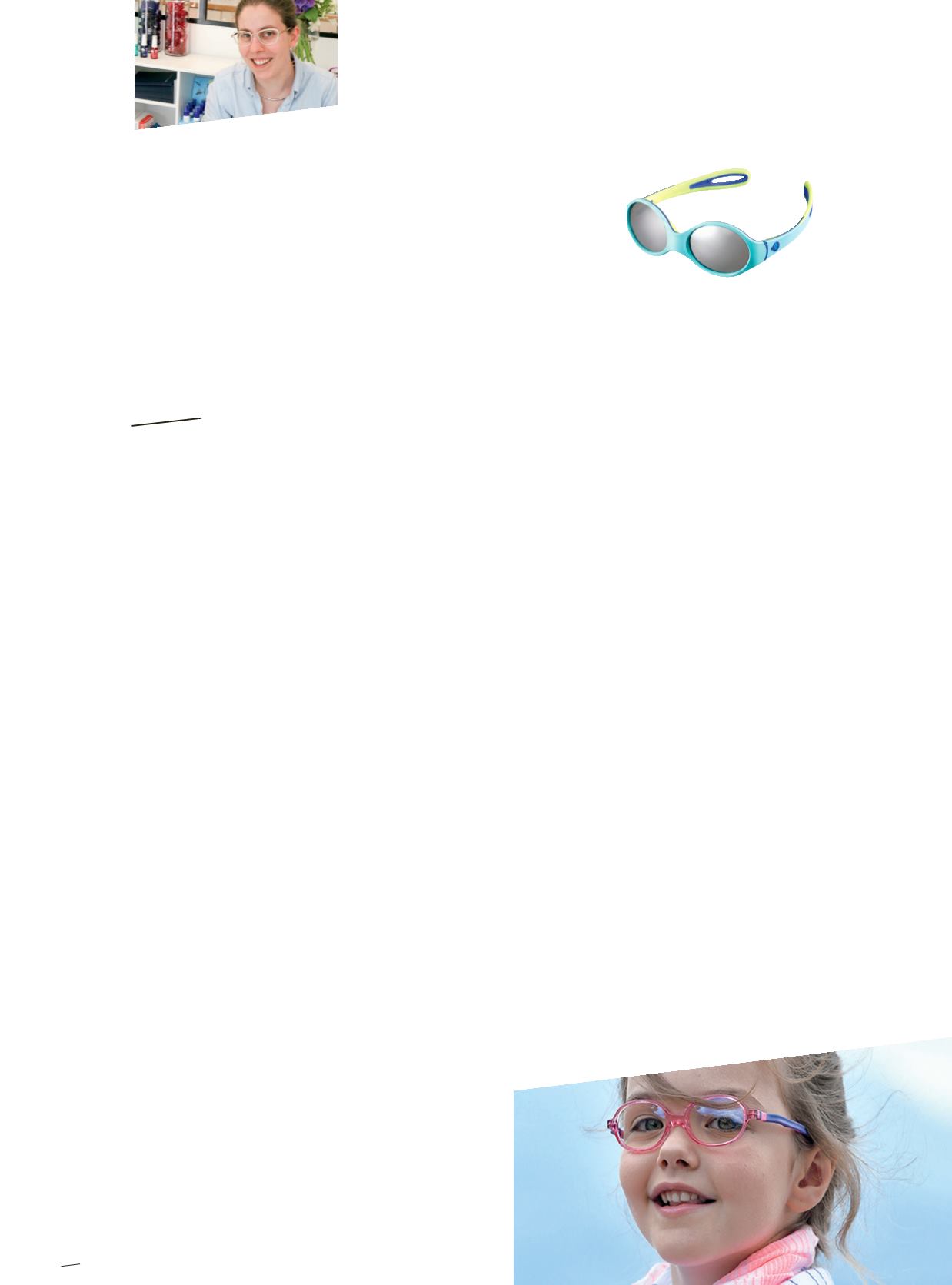

"CHILDREN'S EYES ARE FRAGILE,
AND WE NEED TO DO MORE IN
THE WAY OF PREVENTION."
«L’œil de l’enfant est fragile, il faudrait
faire davantage de prévention.»
AGNÈS TALLEMET
OPTICIAN IN ANTONY (FRANCE)
OPTICIENNE À ANTONY (FRANCE)
Is enough attention paid to children's vision?
Agnès: It depends: parents nowadays pay more attention to
sun protection than to correction. They're much more aware
than they used to be and go to opticians looking for good
category 4 sunglasses. Some parents who are mindful of
the need for sunglasses also pay the same attention to their
children's vision. However, when it comes to optical eyewear,
there are others who still arrive with a first prescription
showing relatively high levels of correction. After a screening
at school, they often fall off their chairs in amazement!
Tell us about children's eyes.
Agnès: They're particularly fragile! And made even more
so because the eyes of young children don't yet filter out
UV light. We need to do more in the way of prevention and
communication, because good solutions do exist! And if parents
wear sunglasses, children unconsciously imitate them. Of
course, some very young children really don't like wearing
sunglasses and a hat and visor have to do the job instead! But as
a general rule, young children shouldn't be exposed to the sun.
There's lots of criticism about the prevalence of screens
everywhere, but what effect do they have on vision?
Agnès: Blue light – from LEDs, computer screens, smartphones
and TV sets – is potentially damaging and particularly for
children! While adults cope with the fatigue caused by this
blue light (they're also exposed to it!), children are obviously
much less aware of the concepts of accommodation and
convergence, in other words, keeping their distance from it!
What makes an effective pair of sunglasses?
Agnès: In addition to the quality of the lens, the frame must
be perfectly adapted to the facial shape of the child: because
the ridge of their nose is flatter than in adults, we need to
make sure that the frame sits perfectly so it can't slide off.
And the smaller the child is, the higher the lens must sit,
as their eyes "look up" towards the world of adults.
Would you give a "good mark" to Julbo for
its optical eyewear and sunglasses?
Agnès: Yes, their models are perfectly adapted, the bridges
well-designed, the shapes highly technical, and the frames
fun and pretty! And there are three sun options, the
category 3 lens, the junior polarized lens and the category
4 mirror lens, all of which are excellent quality.
Est-ce qu’on fait suffisamment attention à la vue de l’enfant ?
Agnès : Ça dépend : les parents font aujourd’hui davantage
attention à la protection solaire qu’à la correction. Il y a une
réelle prise de conscience et on vient chercher chez les opticiens
de bonnes solaires avec un indice 4… Il est possible que les
parents attentifs au solaire le soient aussi quant à la vue de
leur enfant. Mais en optique, certains arrivent encore avec une
première ordonnance dont la correction n’est pas négligeable.
Après un dépistage scolaire, ils tombent un peu de leur chaise !
Parlez-nous de l’œil de l’enfant.
Agnès : Il est particulièrement fragile ! D’autant plus fragile que
l’enfant est jeune et ne filtre pas encore les UV. Il faudrait faire
davantage de prévention, communiquer, car les bonnes solutions
existent ! Et si les parents portent des solaires, le mimétisme
opère. Bien sûr certains tout-petits acceptent mal les lunettes et
il faut compléter par chapeau et visière ! Mais en règle générale,
on ne devrait pas exposer les jeunes enfants au soleil…
On critique beaucoup l’omniprésence des
écrans, mais côté vision ça donne quoi ?
Agnès : La lumière bleue – les LED, les écrans informatiques, des
smartphones ou encore des téléviseurs – est potentiellement
nocive et particulièrement pour les enfants ! Si les adultes
intègrent la fatigue due à cette lumière bleue (ils y sont eux
aussi exposés !), ils sont beaucoup moins attentifs aux notions
d’accommodation et de convergence, au respect des distances !
Qu’est-ce qui fait une lunette efficace ?
Agnès : Au-delà de la qualité du verre, il faut une monture
parfaitement adaptée à la morphologie : tant que l’enfant
n’a pas une arête de nez bien formée, il faut veiller
à une assise parfaite pour que la monture ne glisse pas.
Et plus l’enfant est petit, plus le verre doit monter haut
car son regard « monte » vers le monde des adultes.
Vous donneriez un « bon point » à Julbo
pour ses optiques et ses solaires ?
Agnès : Oui, leurs modèles sont tout à fait adaptés, les nez bien
dessinés, les formes très techniques avec des montures ludiques,
jolies ! Et il y a 3 options solaires, le verre classe 3, le polar junior
et le verre classe 4 miroir qui sont d’une très haute qualité.
84
© F. Boursier









